Zaniah, Eta Virginis (η Vir) is the primary component in a triple star system located approximately 265 light-years away in the constellation Virgo. With a combined apparent magnitude of 3.890, it is the ninth brightest star in Virgo. Zaniah is one of the six stars that form the Y of Virgo, an asterism commonly used to locate the Virgo Cluster of galaxies.
Star system
The Eta Virginis system is composed of the binary star Eta Virginis A and a third component, Eta Virginis B. The system has the stellar classification A2 V, indicating a white main sequence star. The three components have masses of 2.5039, 1.8907 and 1.66 solar masses. The primary star, Eta Virginis Aa, has a surface temperature of 9,333 K and spins at 18 km/s.
Eta Virginis A and Eta Virginis B take 7,896.2 days to complete an orbit, while Eta Virginis Aa and Eta Virginis Ab have an orbital period of 71.7916 days. The components Eta Virginis Aa and Ab are separated by only 0.6 astronomical units (Earth-Sun distances).
The three components were resolved for the first time in 2002, when the system was imaged with the Navy Prototype Optical Interferometer (NPOI). The observations revealed that the components Eta Virginis Aa and Ab were separated by between 4 and 9 milliarcseconds in the sky.
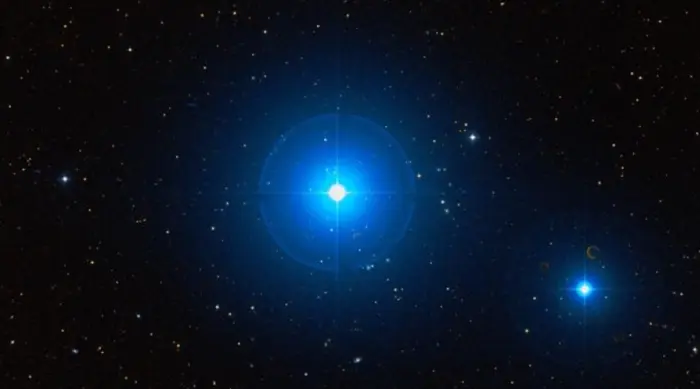
Zaniah (Eta Virginis), image: Wikisky
Facts
Zaniah lies only 1.97 degrees north of the ecliptic and can be occulted by the Moon and sometimes by planets. It was discovered to be a triple star during lunar occultations.
The Greek astronomer and philosopher Timocharis recorded a conjunction of Zaniah and Venus on October 12, 272 BCE. The star was last occulted by a planet (Venus) on September 27, 1843, and will be occulted by Venus again on November 19, 2445.
Zaniah lies between the celestial equator and the ecliptic, about 40’ south of the equator and 5 degrees east of the autumnal equinox. The autumnal equinox is the point where the Sun’s apparent path across the sky (the ecliptic) crosses the celestial equator (the projection of Earth’s equator into space). Zaniah and the brighter Heze (Zeta Virginis) almost exactly trace the line of the celestial equator.
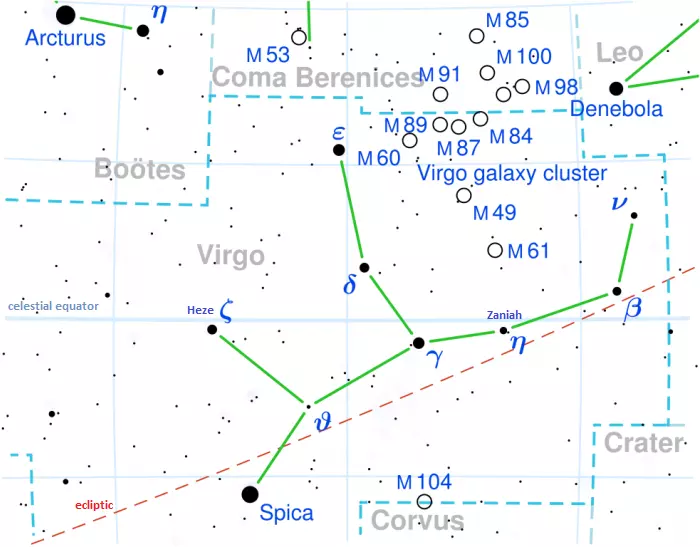
Zaniah, Heze, the ecliptic and the celestial equator, image credit: Torsten Bronger (CC BY-SA 3.0)
Zaniah is one of the six relatively bright stars that form the Y of Virgo, an asterism that dominates the western part of Virgo and makes the constellation recognizable. The crooked Y is formed by the bright Spica (Alpha Virginis), Porrima (Gamma Virginis), Minelauva (Delta Virginis), Vindemiatrix (Epsilon Virginis), Zavijava (Beta Virginis), and Zaniah (Eta Virginis). The asterism can be used to find the Virgo Cluster of galaxies. The centre of the cluster appears roughly halfway between Vindemiatrix, the leftmost star of the Y, and Denebola in the constellation Leo.
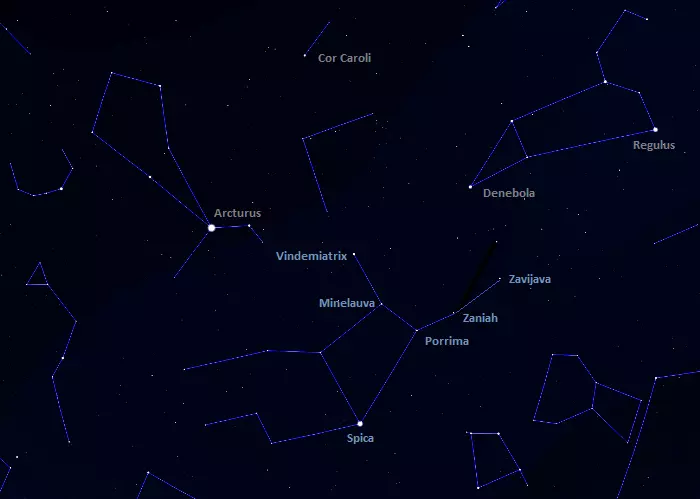
The Y of Virgo, image: Stellarium
Name
The name Zaniah (pronunciation: /ˈzeɪniə/) comes from the Arabic word zāwiyah, meaning “corner,” from the phrase zāwiyat al-cawwa’, “the corner of the barking (dog).” The name refers to an old Arabic asterism. It shares the same etymology as Zavijava (Beta Virginis).
In Arabic astronomy, Zaniah (Eta Virginis), Zavijava (Beta Virginis), Porrima (Gamma Virginis), Minelauva (Delta Virginis), and Vindemiatrix (Epsilon Virginis) formed an asterism known as Al ʽAwwāʼ, meaning “the barker” or “barking (dog).”
The 17th century Egyptian astronomer Al Achsasi al Mouakket called Eta Virginis Thanih al Aoua, meaning “the second barker,” in his Calendarium. The name was later translated into Latin as Secunda Latratoris.
The International Astronomical Union’s (IAU) Working Group on Star Names (WGSN) approved the name Zaniah for Eta Virginis on September 12, 2016. The name formally applies only to the primary component, Eta Virginis Aa, but has traditionally been used for the whole star system.
In Chinese astronomy, Zaniah was called 太微左垣一 (Tài Wēi Zuǒ Yuán yī), the First Star of Left Wall of Supreme Palace Enclosure. The Left Wall asterism was formed by Zaniah with Porrima (Gamma Virginis), Minelauva (Delta Virginis), Vindemiatrix (Epsilon Virginis), and Diadem (Alpha Comae Berenices). Eta Virginis represented the Left Law Administrator (左執法,Zuǒzhífǎ), and the Supreme Palace Enclosure represented the imperial court.
The Chinese also knew the star as Yih Mun, Twan Mun, or Tien Mu, meaning “Heaven’s Gate.”
Location
Zaniah is easy to find because it is part of a relatively bright asterism, the Y of Virgo. It is the middle star in the right part of the crooked Y.
Spica and the rest of the Y of Virgo can be found using the stars of the Big Dipper. Following the arc of the Dipper’s handle across the sky leads first to Arcturus, the brightest star in the northern celestial hemisphere, and then to Spica.
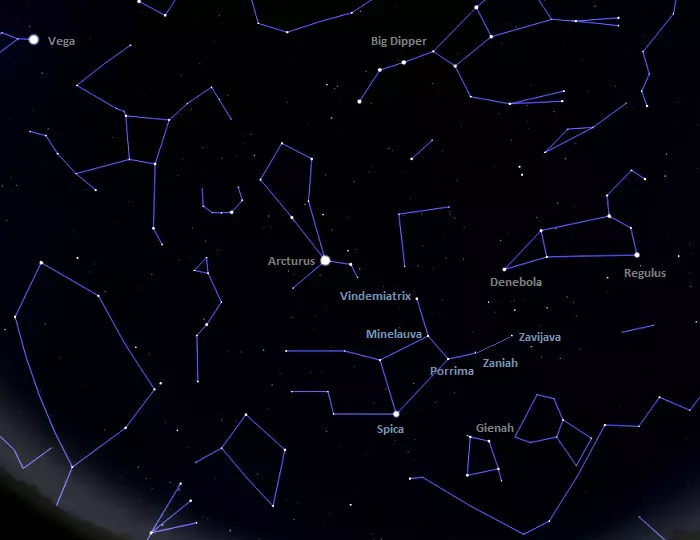
The location of Zaniah (Eta Virginis), image: Stellarium
Spica appears at the base of the Y of Virgo, Porrima is the middle star of the bowl, Zaniah and Zavijava form the right side of the bowl, and the brighter Minelauva and Vindemiatrix form the left side. Zaniah appears between the brighter Porrima and Zavijava. Zavijava appears roughly halfway between Spica and Regulus.
Constellation
Zaniah is located in the constellation Virgo. Virgo is the second largest constellation in the sky, occupying 1,294 square degrees around the celestial equator. As one of the 15 equatorial constellations, it is visible from virtually any location on Earth for at least part of the year.
Like other zodiac constellations, Virgo was catalogued by the Greek astronomer Claudius Ptolemy in his Almagest in the 2nd century CE. Almost all 48 Greek constellations (all except Argo Navis) have survived to this day, including Virgo.
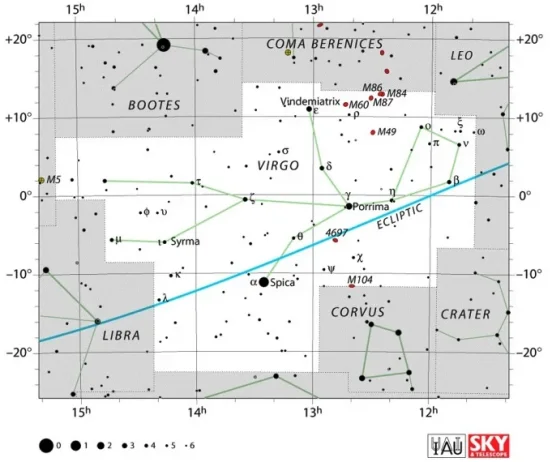
Virgo constellation map by IAU and Sky&Telescope magazine
In Greek and Roman mythology, the constellation Virgo was associated with fertility goddesses Demeter and Ceres. It was also linked with the Greek Dike, the goddess of justice.
Virgo is best known for hosting Spica and the Virgo Cluster of galaxies. Spica, the constellation’s brightest star, is the 16th brightest star in the sky. The hot blue star shines at magnitude 0.97 from a distance of 250 light-years.
The Virgo Cluster lies approximately 53.8 million light-years away and hosts between 1,300 and 2,000 galaxies. The brightest members of the cluster were discovered in the 1770s and 1780s. They include the bright elliptical galaxies Messier 49, Messier 60, Messier 87, and Messier 89, the spiral galaxies Messier 58, Messier 61, and Messier 90, and the lenticular or elliptical Messier 84 and Messier 86.
Virgo also hosts the famous Sombrero Galaxy (Messier 104), which appears near the border with the constellation Corvus (the Crow) and is not a member of the Virgo Cluster.
Apart from Spica, notable stars in the constellation include the yellow giant Vindemiatrix (Epsilon Virginis), the yellow-white giant Syrma (Iota Virginis), the orange giant Kang (Kappa Virginis), the nearby red dwarf Ross 128, and the yellow main sequence star 61 Virginis, which is home to three known extrasolar planets.
The best time of the year to observe the stars and deep sky objects in Virgo is during the month of May, when the constellation appears higher above the horizon in the evening. The entire constellation is visible from locations between the latitudes 80° N and 80° S.
The 10 brightest stars in Virgo are Spica (Alpha Vir, mag. 0.97), Porrima (Gamma Vir, mag. 2.74), Vindemiatrix (Epsilon Vir, mag. 2.826), Heze (Zeta Vir, mag. 3.376), Minelauva (Delta Vir, mag. 3.39), Zavijava (Beta Vir, mag. 3.604), 109 Virginis (mag. 3.72), Mu Virginis (mag. 3.88), Zaniah (Eta Vir, mag. 3.89), and Nu Virginis (mag. 4.04).
Zaniah – Eta Virginis
| Spectral class | A2 V or A2 IV |
| U-B colour index | +0.055 |
| B-V colour index | +0.029 |
| Apparent magnitude | 3.890 |
| Angular size | 0.0017 arcminutes |
| Absolute magnitude | −0.66 |
| Distance | 265 ± 10 light-years (81 ± 3 parsecs) |
| Parallax | 13.1692 ± 0.7356 mas |
| Radial velocity | +5.24 ± 0.19 km/s |
| Proper motion | RA: -54.665 ± 0.799 mas/yr |
| Dec.: -17.642 ± 0.771 mas/yr | |
| Mass | 2.5039 ± 0.1246 M☉ (η Vir Aa), 1.8907 ± 0.0932 M☉ (η Vir Ab), 1.66 ± 0.16 M☉ (η Vir B) |
| Temperature (η Vir Aa) | 9,333 K |
| Metallicity (η Vir Aa) | +0.11 dex |
| Rotational velocity (η Vir Aa) | 18 km/s |
| Surface gravity (η Vir Aa) | 3.0 cgs |
| Constellation | Virgo |
| Right ascension | 12h 19m 54.3423981961s |
| Declination | –00° 40′ 00.466313213″ |
| Names and designations | Zaniah, Eta Virginis, η Vir, 15 Virginis, HD 107259, HR 4689, HIP 60129, FK5 460, SAO 138721, BD+00°2926, AG-00 1719, GC 16813, GCRV 7391, JP11 2206, NSV 5555, PPM 178753, PLX 2840, UBV 11070, IRAS 12173-0023, 2MASS J12195437-0040002, TYC 4940-1158-1, Gaia DR2 3695061317956684160, Gaia DR3 3695061317957036928, ADS 4689 AB, CCDM 12199-0040, WDS J12199-0040 |